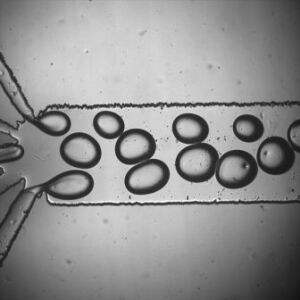Blood Analysis Laboratory Could Be Size of Shoebox One Day
by
Brendon Nafziger, DOTmed News Associate Editor | September 03, 2009

Fluid passing through micro-capillary
Researchers at the University of Southampton in Britain have created a device which one day might allow doctors to perform all blood tests on a device the size of a shoebox, according to a paper published this month in the journal Lab on a Chip.
Called a microfluidic single-cell impedance cytometer, the device works by using a chip etched with microscopic capillaries -- only 10-to-100 microns in size -- that allow liquid to pass through, in this case, blood. Tiny electrodes in the device are able to read the electrical properties, or impedance, of the blood cells, which are unique to each kind of cell and can be used to identify them.
For the study, the scientists performed a white blood cell differential, counting the different kinds of leukocytes found in the sample, one of the most common types of blood laboratory tests, according to the researchers.
"The idea was to get away from tagging or labeling cells," Professor David Holmes, a postdoctoral research fellow at the University of Southampton's Nano Research Group, and lead author on the study, tells DOTmed News. The traditional, expensive method of laboratory analysis involves identifying or counting blood cells after they've been tagged by antibodies bearing fluorescent dyes. "Measuring inherent properties based on electrical impedance properties," Holmes claims, is more efficient, and will lead to portability, speed and miniaturization of diagnostic systems.
"To do blood analysis," he says, "you have to take a sample from the patient, send it to a centralized lab, and wait a few days." But microfluidics might allow doctors to use point of care devices that would give their patients instant results during their visit.
But portable blood tests offer more than just convenience -- they could save lives. Holmes says that in resource-poor settings like Africa, a cheap, small and durable device would make HIV-testing in remote areas much easier. Now, Holmes says, most portable blood analysis systems are heavy, weighing upwards of 40 pounds, and use fragile optics. "You can't carry it," he says, "because if you bash it the lasers get misaligned. Using our chip for integrated electronics, you can drop them on the floor without any worry."
Philips Electronics is currently working with Holmes' team to make the technology commercially available. Holmes predicts that a device could hit the market in three-to-five years, and go for under £1,000. There's a "big market out there for simple blood analysis systems," he notes.
Meanwhile, Holmes hopes microfluidic cytometers will let them create other tests for blood cells. He believes they'll eventually be able to use these cytometers to determine the structure of the cell membrane and even the volume of DNA the cell's holding -- clues that will tell them both the kind of cell it is and where it is in its life cycle, which could be useful for diagnosing or treating illnesses like cancer.
Beyond medicine, these technologies might have other applications, too. "Anything in a fluid suspension" could be tested with these devices, Holmes says. You could "look for wear in engines," he says. "You could pass engine oil through an impedance based cytometer to look for bits of metal."
